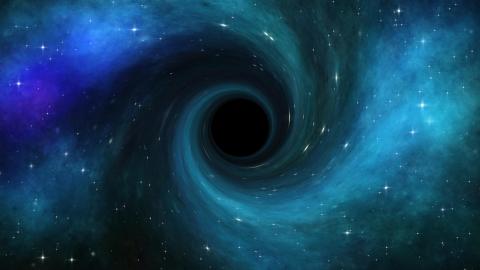Study finds new ways of detecting dark matter in black holes

Credit: Magann / Adobe Stock.
- A new paper narrowed down what type of black holes may be the best candidates for containing dark matter.
- So far, dark matter has not been directly observed.
- The research team also developed new techniques to spot Hawking radiation that potentially comes from black holes.
Predicted to account for over 80 percent of all matter in the universe, so far, no one has directly seen dark matter. This is perhaps not surprising for a substance that doesn’t reflect or emit any light. Now, a new study examines the possibility of finding dark matter in primordial black holes (PBHs), structures that hypothetically formed in the early life of the universe.
The paper, authored by scientists at the University of Amsterdam and the University of California-Santa Cruz and published in Physical Review Letters, looked to narrow down the parameters PBHs would need to contain dark matter. The authors also proposed a technique that could find dark matter by looking for so-called Hawking radiation.
What is Hawking radiation?
The late Stephen Hawking proposed the existence of thermal radiation that spontaneously emanates from black holes. He hypothesized the radiation was created by quantum effects near the black hole’s event horizon, the boundary beyond which no light can escape. Furthermore, Hawking believed that over time, the radiation would result in enough energy and mass being taken away from a black hole to make it evaporate completely.
In the new paper, the researchers calculated the likely mass constraints of PBHs that could be composed of dark matter. Specifically, they concluded that PBHs similar to an asteroid in size (around 1017 grams to 1022 grams) could “make up all the dark matter” in the universe. Furthermore, the study looked at new techniques for finding dark matter, examining the possibility of using MeV (megaelectron volt) gamma-ray telescopes to detect Hawking radiation coming from the primordial black holes.
In an interview with Phys.org, researcher Adam Coogan explained why their approach could work.
“The main idea behind our work was to think about a particular way of looking for asteroid-mass PBHs,” Coogan shared. “Light PBHs are expected to emit Hawking radiation consisting of a mix of photons and other light particles, such as electrons and pions. Telescopes can then search for this radiation by observing our galaxy or other galaxies.”
Paving the way for future telescopes
Coogan added that the goal of their paper was to evaluate if future telescopes would be able to spot this radiation and “how much of the asteroid-mass PBH parameter space they could probe.”
What the researchers discovered is that previous studies have not yet analyzed data from NASA’s COMPTEL gamma-ray telescope aboard the Compton Gamma Ray Observatory (CGRO). Utilizing the telescope’s data could help narrow down the PBHs that need to be examined to those just below the asteroid-mass gap (that is, below 1017 grams). These would comprise the strongest constraints found so far and could lead to further discovery.
Two ways dark energy could destroy the universe | Katie Mack | Big Thinkwww.youtube.comThe scientists also refined the calculations necessary to spot the spectrum of the hypothesized Hawking radiation supposedly emitted by a primordial black hole. Specifically, they improved upon the detection of radiation produced by electrons and pions within the spectrum.
The team’s calculations could help determine how much PBHs of particular masses contribute to the overall amount of dark matter in the universe. Comparing their calculations of the radiation spectrums to observed data from areas believed to contain a lot of dark matter, like the center of the Milky Way, could help scientists rule out or zero in on certain black holes as dark matter candidates.
Looking ahead, the researchers believe that the next generation of MeV gamma-ray telescopes would be able to find dark matter in primordial black holes by directly detecting Hawking evaporation.





